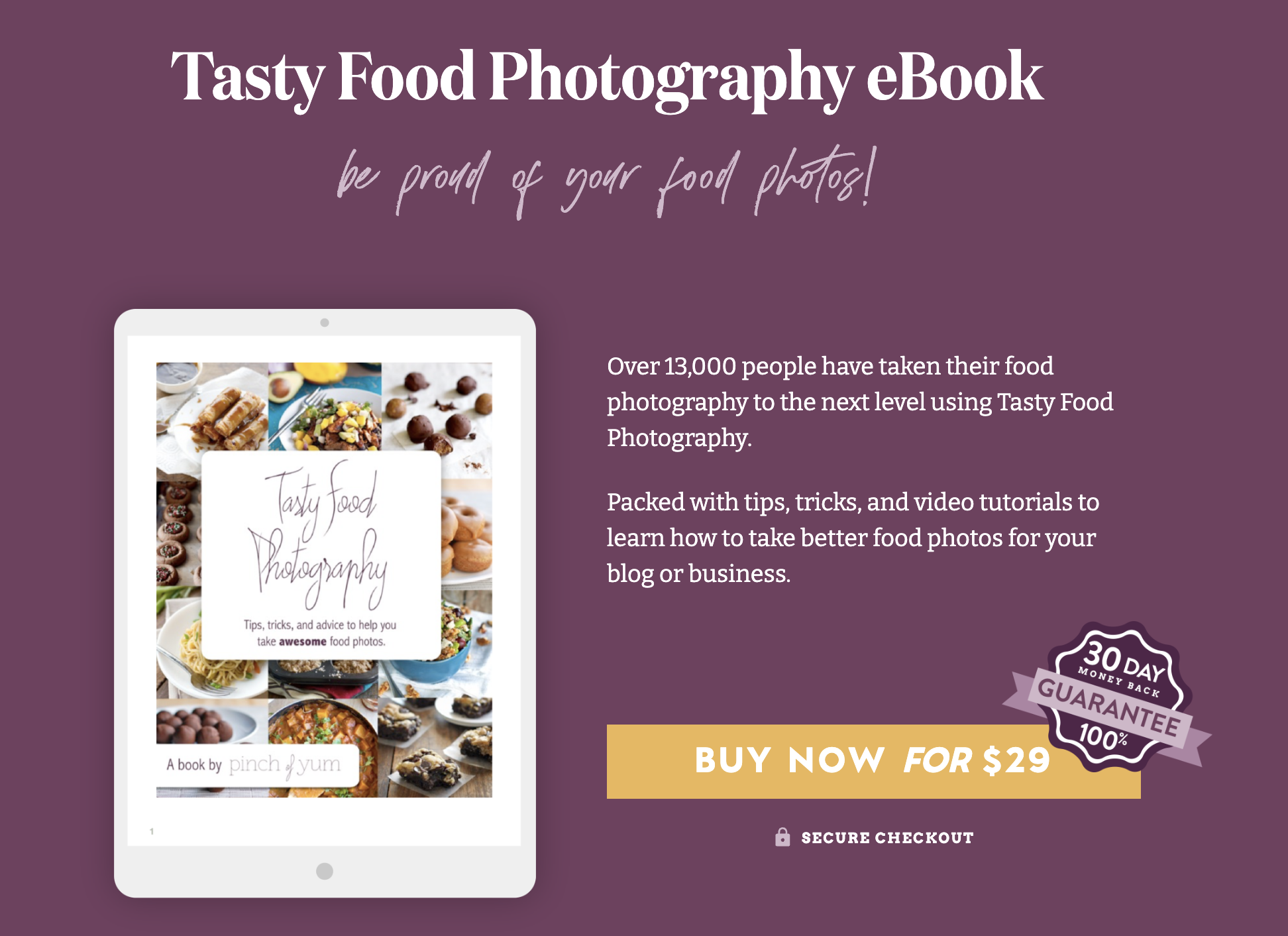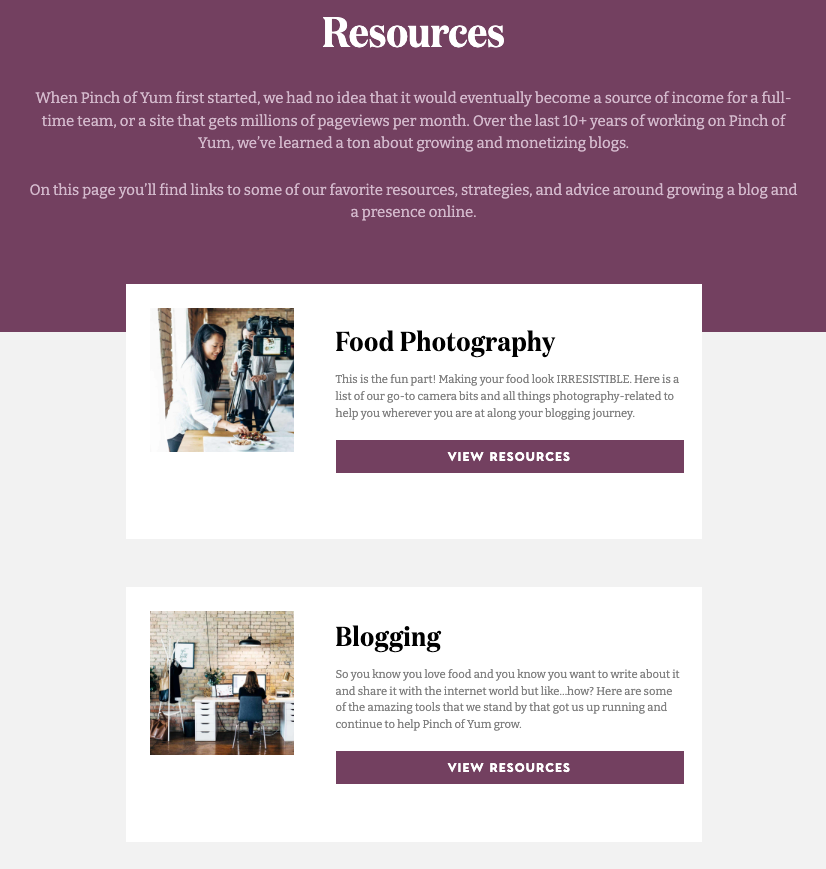If you’re making a dollar from your food blog, you could probably be making two. If you’re making $100, you could probably be making $200. If you’re making $1,000, you could probably be making $2,000. I could keep going with that, but you probably get the gist by now: it’s time to maximize your blog’s earning potential! 💰
While it may be easy to increase your blog’s income by adding additional ad units, writing spammy posts with many affiliate links, or pitching unrelated or untested products to your readers, the goal here is to increase your revenue-making capabilities without degrading the quality of your site.
The more value you can provide to your readers, the easier it is for them to return to your blog. Words to live by!
Let’s explore some ways you can amplify your monetization strategies in this post!

1. Create and sell an eBook
Picture this: You’re a food blogger who’s worked hard to develop, test, photograph, and write recipes for your site. After running your blog for a while, you’ve accrued a number of skills unique to food blogging, but the only income you’ve made has been from the few ads you’ve placed on your site.
Now what? 😬
If this sounds like you, it’s time to put those skills to work. Round up your 30-minute dinner recipes or your trusted photography tips and start working on an eBook!
I’m a staunch believer in working smarter, not harder (okay, a little hard work is warranted sometimes), so if you’re going down the cookbook route, my recommendation is to let a digital cookbook template do the heavy lifting for you. You can purchase a template on Etsy, or you can even use Canva’s free templates!
You already have your recipe images, ingredients, and instructions handy so all you’ll have to do is pop them into the template and voilà! You’ve got yourself a cookbook that you can sell to your audience by promoting it on your blog, email newsletter, social media, etc.
Real-life example: Pinch of Yum’s food photography eBook, Tasty Food Photography, launched a while back and has helped over 13,000 bloggers take their photography to the next level!

2. Offering services to bloggers
What’s your favorite part about running a food blog? Have you grown to love food photography? Or maybe you just love spending time in the kitchen whipping up new recipes?
Guess what? You can leverage those skills and offer your services to other food bloggers! There are always other bloggers out there looking to outsource certain tasks, and you might just be the perfect fit for someone.
Yes, that means you could actually get paid to do what you love. 😱 If that sounds like something you are interested in and have the bandwidth for, take some time to create a unique “job” description and price out your work. Join a few Facebook Groups to test the waters and see if anyone is interested in hiring you as their next photographer, writer, social media expert, etc.
3. Create an email newsletter
The email newsletter is one of the most reliable tools you can have at your disposal to build traffic and grow your business.
Let’s say Google changes up its algorithm (lol, never), and you start to see your top recipes drop in rank. Or a social media platform ends up going kaput. It would be a heck of a lot harder for you to build your audience back up if you were relying on other platforms to keep that traffic flowing to your site. 👎
With an email newsletter, you have a loyal and stable audience that is guaranteed to continue receiving your content. And believe it or not, you can actually monetize your email newsletter!
One of the easiest ways to do so is to drive traffic back to your blog so you can continue to earn that sweet, sweet ad revenue. You can also promote any digital products or services (we’ve really come full circle here 🙌) to your audience and drive more sales!
Interested in learning more ways to monetize your email list? Check out our blog post, 6 Ways You Can Make Money with Your Email List, authored by email marketing expert Allea Grummert from Duett!
4. Create a resources page
If you’re running a food blog, chances are you’ve got some plugins, tools, and/or equipment that help you keep things humming. You’ve done all of the research, testing, installing, uninstalling… you get the gist.
What are you going to do with all of this experience that you’ve got under your belt? Create a resources page (with affiliate links) to serve as a guide for those looking to start their own food blog! 🙌
You’ll not only provide a wealth of invaluable information to your readers (remember what we said about providing value earlier?), but you’ll also earn revenue from any purchases made through your affiliate links.
Many plugin and hosting companies have affiliate programs that you can sign up for, so be sure to check those out and apply for the programs beforehand. Then, you’ll want to think about the physical tools and equipment that you use on a regular basis, such as your camera, standing desk, etc.
Once you’ve got your list, you can create a Page in WordPress and make it available for your readers to read through. Check out Pinch of Yum’s Resources page below! ⬇️

5. Brand deals and sponsorships
Brand deals and sponsorships can be the key to turning your passion into a profitable venture! Imagine getting paid to talk about your favorite kitchen gadgets or drool-worthy ingredients. It’s like getting paid to eat, right?
By partnering with complementary brands, you can not only build recurring income but also boost your blog’s reach and influence. Imagine showcasing your culinary creations with top-quality ingredients or kitchen tools, all while earning a commission. 🤑
Something worth noting is that it’s important to maintain authenticity and align with brands that you actually value and will resonate with your audience. Remember, your readers trust your recommendations, so you should still aim to create high-quality content to establish yourself as a trusted voice in the food blogging sphere!
From sponsored recipe development to product reviews and social media campaigns, the possibilities with brand deals and sponsorships are endless!
So there you have it! These are just a few additional ways that you can make more money from your blog outside of your usual affiliate links and ad revenue.
Which one of these five things are you not doing that you could take action on? I’d love to hear if you implement one of these things and what the result is.
This is all such good stuff, have kind of hit a plateau at the moment for driving traffic to my site http://www.thebantwagon.com, and in turn have obviously hit a plateau with my earnings.
Am investigating the whole emailer thing at the moment, and then will need to start tailoring some content to it, as a niche food blog do you have any tips on how I can draw a wider ranging audience?
Finding your blog really helpful so far!
Nick.
Happy to hear you found it helpful!
Great question – it sounds obvious but you might need to “niche up.” If you’re finding that your niche is too small then it might be time to widen your target market.
Today marks 3rd anniversary of my blog Bjork but until last year I never took much effort or should I say I just had no idea how to make it to something I always wanted to. Working hard on the tips you have given and hoping to turn my blog into a business I have always been dreaming of. But as you say, action > advice, yes!!
thanks for sharing
Of course!
All of this is really valuable information, I’ve reached a point where I’m not seeing any growth in traffic to my website https://mcmenus.co.uk/ , which means my earnings have also stagnated.
Currently, I am looking into the emailer situation and will soon begin customizing content for it.
I have found your blog to be incredibly useful thus far!
Hi Sim – happy to hear you’ve found it useful. Best of luck!